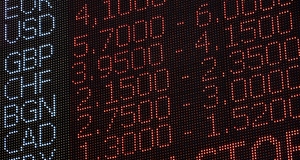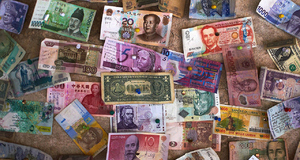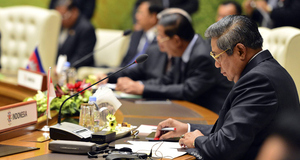From The Developing Economist VOL. 1 NO. 1The Implausibility of the Barter Narrative & Credit Money in Ancient Babylon
IN THIS ARTICLE
KEYWORDS
AbstractWhereas the standard economics textbook literature motivates the emergence of money by pointing to the inefficiencies of barter economies, there is virtually no historical evidence that this is how money actually came about. Due to the lack of evidence for the existence of barter economies, an attempt is made therefore to hypothesize an origin of money which is more compatible with the organization of early societies. This alternative story is explained with the help of a model of four trading merchants, in which barter is shown to be dominated by credit simply on the basis of bargaining power and the ability of a centralized middleman to complete transactions between agents. This simple model represents the ability of individuals and institutions in establishing units of account. The organization of economic transactions around lines of credit is supported with historical evidence and is found in one of history's earliest civilizations. The codification of the loan contract in ancient Babylon, when combined with the historical evidence and simple thought experiments about the viability of credit, demonstrates that credit systems are a more historically viable starting place for the emergence of money than barter. I. IntroductionThe usual textbook account of the emergence of money in human societies treats money as the solution that arose to address the inefficiencies of barter economies. This narrative has a long history spanning over two millenia – the story has been speculated upon by Aristotle, was made explicit by writers like Adam Smith, is even used as an acceptable starting point for modern papers on the topic, and finally is suggested as the correct explanation in the thought experiments of modern economics textbooks. There are a few major problems with this narrative however:
II. Money as Defined in the Barter NarrativeIn textbook discussions and in the general literature, money is most often defined functionally2 as that which is3:
These functions convey that ‘money is what money does', a notion used due to the complicated history of what we would colloquially refer to as money. In the modern literature a wide variety of definitions for money exist, and while ten of the prominent definitions have been catalogued (Osborne, 1984), the functional definition is both the definition used in the barter narrative and one sufficient to highlight a major flaw in the economic literature that exists today. Of the three functions listed above, one reasonable question might be ‘which is the most important feature of money?' or ‘which is the most essential?'. Depending on the perspective, and especially depending on the time and place in history, there are reasonable arguments to be made for each of these functions being the dominant or quintessential function of money. In the literature however, the barter narrative overemphasizes the role of the medium of exchange function to the point at which it distorts our view of how economies actually operated. In early societies like ancient Babylon, the monies of the day (standardized weights of silver and barley) were used primarily as units of account and a means of payment on debt. The word ‘barter' is sometimes used loosely to mean any form of exchange of goods and services without the use of money, but that is not how the word is used in the barter narrative. In the barter story, traders confine themselves to transactions in which goods and services are exchanged simultaneously among willing participants. Thus there are no mechanisms for credit or gifting between two trading partners, and the practical methods of theft and swindling are ignored. This restricted form of trading is how the word ‘barter' is traditionally used in textbooks. The barter narrative as implicit in textbook discussions of moneyTextbooks often justify the existence of money, alluding to the barter narrative, by introducing the double coincidence of wants problem. That is, if two agents wish to trade they must both have something the other wants. Because the two agents are unlikely to be able to match up their wants with what they actually have to trade, they are not likely to find a good trade to make. A recent textbook example illustrates this point, invoking the double coincidence problem and arguing that money solves it with the medium of exchange function: "The use of money as a medium of exchange permits trade to be accomplished despite a noncoincidence of wants... ...Suppose that Nebraska has no interest in Florida's oranges but wants potatoes from Idaho, [Idaho wants some of Florida's oranges but none of Nebraska's wheat, and] Florida wants some of Nebraska's wheat but none of Idaho's potatoes. We summarize the situation in figure 2.1. In none of the cases in the figure is there a coincidence of wants. Trade by barter clearly would be difficult. Instead people in each state use money, which is simply a convenient social invention to facilitate exchanges of goods and services. Historically, people have used cattle, cigarettes, shells, stones, pieces of metal, and many other commodities, with varying degrees of success, as money." – McConnell, 2012 This is a convincing argument that if money were to suddenly vanish in the modern economy, money would solve many of the inefficiencies caused by the lack of it. While this is a good point to make to students of the modern economy, it does not address the origins of money but rather illustrates a likely origin of our misconceptions. We are told to consider an economy organized around trade with money, and then asked to imagine how hard it would be for such trades to continue without it. It is important to emphasize that this particular phenomenon of money reemerging has occurred in history. For instance, Cigarettes (mentioned by McConnell et al in the above quote) were used in POW camps in the second world war as currency by prisoners familiar with the concept of money as a medium of exchange (Radford, 1945). Thus economists are faced with a problem – every writer on the emergence of money writes from a perspective of having witnessed money in a modern form. Thus, in order to understand the origins of money beyond the confines of conjecture, it is necessary to examine what less modern societies actually did with their resources. But even when this is done, care must taken to not connect the dots. Modern money is only one of many ingredients in modern economies, and so it is not necessarily true that money, as we are familiar with it, emerged in an economy with strong divisions of labor or in one with notions of private property. History shows that nature of money does not remain constant in all its varied social and economic contexts even if it satisfies the three-function definition. The emphasis on one function may not always be clear or insightful, since what we call money has traditionally satisfied all three. The textbook rendition of the barter narrative thus poses a serious threat to the value of the three function definition, because it argues effectively that the only function that really matters is the medium of exchange function. To illustrate how unnecessary the medium of exchange function is in this particular case, we could equally well have argued that Nebraska, Florida, and Idaho could have solved their double coincidence problem with a different convenient "social invention" – credit. If people in Nebraska had taken out a loan of oranges from Florida, and traded some of them for potatoes from Idaho, the loan could be repaid in wheat. The only issue remaining is that Nebraska must be able to gauge how much wheat an orange is worth. To accomplish this, they all settle on a standard unit of account which they might call a ‘dollar', and thus by comparing their goods to a dollar's worth, Nebraska and Florida can mutually agree upon whether the loan has repaid. Note that here, the emphasis is on the unit of account function and practically no mention is made of the fact that a dollar might actually also be a physical thing that can be traded directly and serve as a medium of exchange. Thus we have a drastically different story of why money might be useful which solves the same problem. When physical money is in short supply, it is possible for traders to continue on without it, simply by denominating their loans in the standard of value the physical money is meant to embody. The barter problems set up in modern textbooks are therefore misleading in that one does not actually need money to solve them – an alternative is credit without a medium of exchange. Because there are multiple solutions to this problem theoretically, it is not so surprising that the emphasis the barter narrative has placed on the medium of exchange function has led to misinterpretation of the history. III. Adam Smith and the Barter NarrativeOne notable example of such a misinterpretation comes out of Smith's seminal text, An Inquiry into the Nature and Causes of the Wealth of Nations, in which there is an entire chapter devoted to "...the Origin and Use of Money". In this chapter, Smith contends that the double coincidence of wants problem must have stimulated the invention of money by means of a commodity "few people would be likely to refuse" becoming a widespread medium of exchange. "But when the division of labour first began to take place, this power of exchanging must frequently have been very much clogged and embarrassed in its operations. One man, we shall suppose, has more of a certain commodity than he himself has occasion for, while another has less. The former, consequently, would be glad to dispose of; and the latter to purchase, a part of this superfluity. But if this latter should chance to have nothing that the former stands in need of, no exchange can be made between them. The butcher has more meat in his shop than he himself can consume, and the brewer and the baker would each of them be willing to purchase a part of it. But they have nothing to offer in exchange, except the different productions of their respective trades, and the butcher is already provided with all the bread and beer which he has immediate occasion for. No exchange can, in this case, be made between them. He cannot be their merchant, nor they his customers; and they are all of them thus mutually less serviceable to one another. In order to avoid the inconvenience of such situations, every prudent man in every period of society, after the first establishment of the division of labour, must naturally have endeavored to manage his affairs in such a manner, as to have at all times by him, besides the peculiar produce of his own industry, a certain quantity of some one commodity or other, such as he imagined few people would be likely to refuse in exchange for the produce of their industry." – Smith, 1776 Smith goes on to say that metals are an excellent candidate for such a commodity since they are commonly durable, fungible, divisible, and easy to transport. He goes on to give examples of commodities which presumably filled this function in historical economies: "Salt is said to be the common instrument of commerce and exchanges in Abyssinia; a species of shells in some parts of the coast of India; dried cod at Newfoundland; tobacco in Virginia; sugar in some of ourWest India colonies; hides or dressed leather in some other countries; and there is at this day a village in Scotland, where it is not uncommon, I am told, for a workman to carry nails instead of money to the baker's shop or the ale-house." – Smith, 1776 Thus, Smith argues for the barter narrative: as economies developed finer divisions of labor, the double coincidence of wants problem grew and so people began to stockpile commodities which would be acceptable in all trades and these commodities can be called money. However, history shows that these societies Smith relies on for his argument could not have relied upon money as a medium of exchange, because there just was not that much money to go around to fulfill the needs of ordinary people. At the time, these societies were using money, but rather as a unit of account. What we often think of as the primary function of money in modern textbooks and even what Adam Smith thought of as the primary function of money, was not what money was primarily used for. As anthropologist David Graeber points out, "[W]hat Smith describes was really an illusion, created by a simple credit arrangement...[Smith's examples] were ones in which people were improvising credit systems, because actual money – gold and silver – was in short supply" (Graeber, 2011). "Employers in Smith's day often lacked coin to pay their workers; wages could be delayed by a year or more...The nails were a de facto interest on what their employers owed them. So they went to the pub, ran up a tab, and when occasion permitted, brought in a bag of nails to charge off against the debt...The law making tobacco legal tender in Virginia seems to have been an attempt by planters to oblige local merchants to accept their products as a credit around harvest time. In effect, the law forced all merchants in Virginia to become middleman in the tobacco business, whether they liked it or not; just as all West Indian merchants were obliged to become sugar dealers, since that's what all their wealthier customers brought in to write off against their debts." Graeber, 2011. Thus, though John Smith cites these various commodities as historical examples of money emerging as a medium of exchange to solve the inefficiencies of barter, the evidence Graeber points to argues that the stage for their emergence was not set by barter, since the records of their actual behavior indicates the goods were primarily used to settle debts which were denominated in conventional money. The account of dried cod in Newfoundland is most explicit, and was written by the accountant Thomas Smith in 1832. " ‘At Newfoundland, it is said, that dried cod performs the office of money; and Smith makes mention of a village in Scotland where nails are made use of for that purpose.' ... neither of these articles ever was used or could be used as money; and had Mon. Say, instead of servilely copying from Adam Smith and others, almost verbatim, only taken the pains to investigate cases, he would have soon found out this. A very considerable intercourse has long existed betwixt some of the ports of France and one portion of Newfoundland, and he might easily have ascertained from any of the traders in those ports, as to the fact he mentions... No doubt when a person there is in possession of codfish, fully cured or fit for market, he can at all times obtain in return for them any articles that he may require; he has only to go to a store keeper, tell him that he has got the fish and state the articles he wishes in return and a negociation is immediately entered into. But the fish are not taken as money, neither do the parties make a swap of it, that is, make a rough exchange; on the contrary they make a fair a regular barter, calculating the exact value of the articles on each side, according to the rates they agree on;... If the parties are on the French side they use the term livre, if on the English it will be the pound and its diminutives, shillings and pence... a balance is struck. Should that be against the planter4 he generally engages to pay it in fish at a future period, seldom having any other means. Should it be in his favour the merchant gives him a draft for the amount, either on France or England, which he pays away. In the English settlements such drafts for sums varying from five shilling to five pounds, pass as cash, and will circulate there for years before being sent home, being in fact almost the only circulating medium." – Smith, 1832 In short, dried cod didn't really fulfill any of the three functions of money – it merely served as a means of payment. Passages like the one above highlight the difficulty in accepting examples from the past that writers considered to be money: the three-function definition of money is actually very stringent. The examples used by Adam Smith to solve the coincidence of wants problems were only sometimes money, and less than half of them were conclusively used as media exchange.Continued on Next Page » Suggested Reading from Inquiries Journal
Inquiries Journal provides undergraduate and graduate students around the world a platform for the wide dissemination of academic work over a range of core disciplines. Representing the work of students from hundreds of institutions around the globe, Inquiries Journal's large database of academic articles is completely free. Learn more | Blog | Submit Latest in Economics |



















